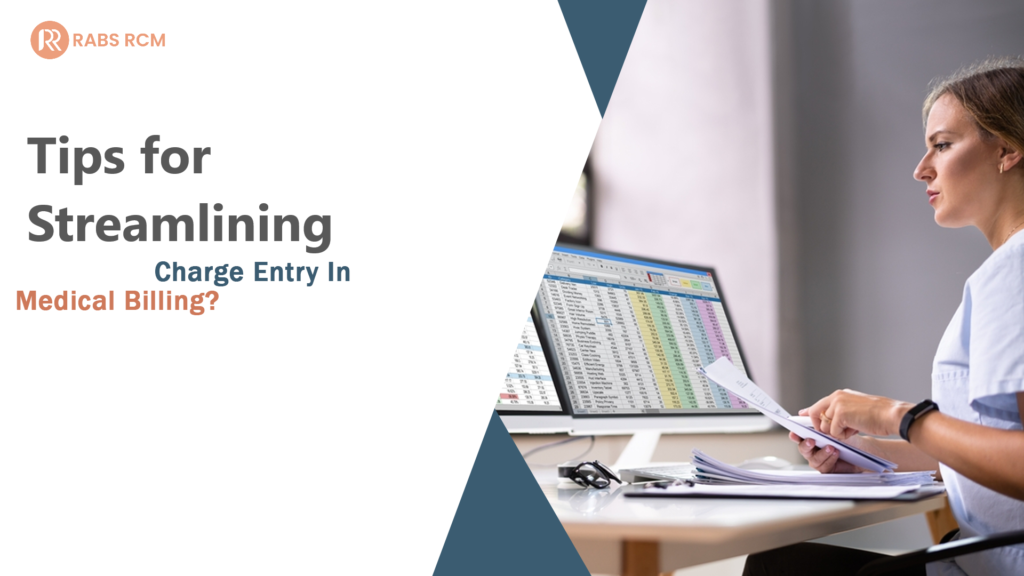Copyright © 2022 Rabs-RCM. All Rights Reserved.

Tips for Streamlining Charge Entry in Medical Billing
Medical billing is a complex procedure requiring meticulous attention to detail and precision to ensure all costs are correctly documented and submitted for reimbursement. One area where medical clinics might improve their billing process is charge entry.
“Charge entry is the process of registering costs for services provided to patients.”
It is an essential phase in the medical billing process since it affects a practice’s compensation. This blog will discuss various methods for simplifying charge input in medical billing.
What is Charge Entry In Medical Billing
In medical billing, a charge entry refers to the process of recording the services provided to a patient along with their associated charges. This includes documenting procedures, treatments, medications, and other medical services rendered during the patient’s visit. The charge entry phase is crucial as it ensures accurate billing for the services provided, facilitating reimbursement from insurance companies or the patients themselves. Medical coders or billing specialists are typically responsible for entering these charges into the healthcare facility’s billing system, adhering to coding guidelines and regulations to ensure compliance and accuracy in billing practices. Efficient charge entry helps streamline the revenue cycle management process and provides proper reimbursement for healthcare services rendered.
Standardize Charge Entry Processes
Standardizing the procedure is one of the most significant tasks in expediting charge input. This implies that all employees in charge of charging should adhere to the same processes. This will guarantee that charge entries are consistent and accurate, reducing mistakes and possible payment denials and delays. Employees should be taught the standardized procedure, and frequent audits should be performed to guarantee compliance.
Use Electronic Health Records (EHRs)
Electronic Health Records (EHRs) have transformed how medical practices manage patient information. EHRs can also help to improve charge entry. EHRs may be customized with charge capture templates, making it easier for employees to document costs. EHRs may also be set up to automatically input charge codes depending on the services delivered, decreasing the amount of manual data entry necessary.
Introduce Charge Capture During Patient Care
Charge capture refers to documenting costs at the point of care. This implies that employees record charges as they give services to patients. This procedure is more efficient than reporting costs after the event since it lowers the possibility of mistakes and omissions. Charge capture can be implemented via portable devices or mobile applications that allow employees to quickly and simply document charges.
Create a Charge Master
A charge description master (CDM) is a detailed record of all the services a medical practice offers and the corresponding fees. To ensure that charges are recorded correctly and consistently, employ a chargemaster. To consider modifications to services and fees, the chargemaster should be updated and evaluated regularly.
Regularly Monitor and Analyse Charge Entry
Medical practices can find opportunities for improvement by routinely monitoring and analyzing charge input. Monitoring and evaluating key performance indicators (KPIs) regularly, including charge entry accuracy, rejections, and days in accounts receivable, is essential. This will enable medical practices to understand patterns better and implement process improvements for charge entry.
Implement Quality Assurance Checks
Checks for quality assurance can assist in identifying mistakes and discrepancies in charge input. To guarantee that charges are correctly submitted and consistently, consider implementing routine quality checks.
Train Staff Members On Charge Entry
Proper training is necessary to guarantee that employees comprehend the significance of charge entry and the steps involved in entering charges. Consider offering frequent training to ensure staff members are informed of any updates or changes to the charge entry procedure.
Conclusion
Simplifying charge input in medical billing is essential to guarantee timely and correct payment for patients’ services. Medical practices may enhance their billing procedure and lower mistakes and payment delays by standardizing charge entry procedures, utilizing electronic health records, adopting charge capture at the point of treatment, developing a charge master, and routinely monitoring and analyzing charge input.

- Our seamless and streamlined efforts, experience, as well as commitment to our clients, all come together to provide both you and your patients with a remarkable experience to remember.
Contact Us
- 2612 62nd St NW Rochester MN 55901 (USA)
- (507) 262-4566
- info@rabs-rcm.com

